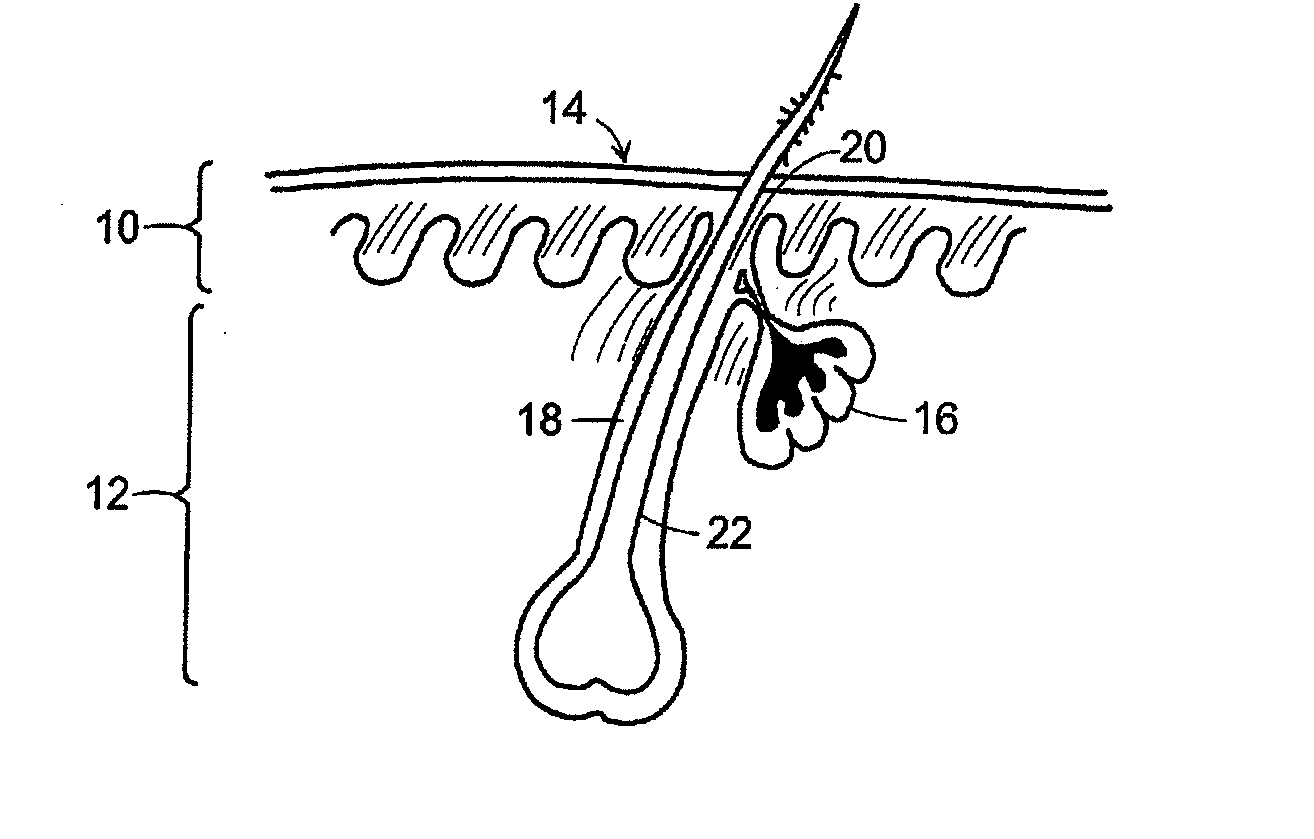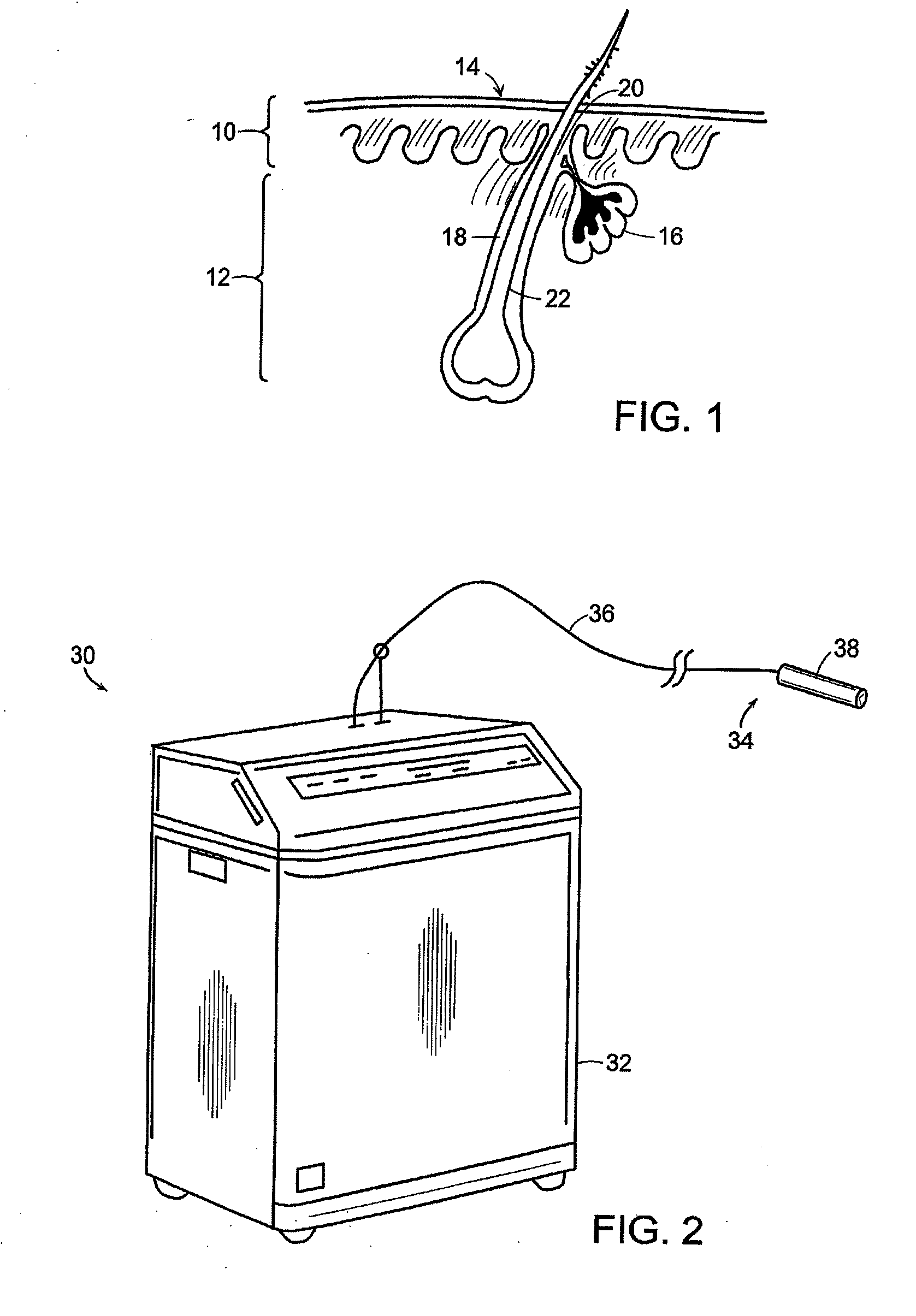Method of Treating Disorders Associated with Sebaceous Follicles
a sebaceous follicle and mammalian skin technology, applied in the field of sebaceous follicles-associated mammalian skin disorders, can solve the problems of affecting the normal functioning of the skin, the formation of pustules and scarring, and the abnormal adhesion of epithelial cells and plugging of the duct, so as to minimize the side effects of trauma and scar formation, reduce the appearance of erythema, blistering, and pain
- Summary
- Abstract
- Description
- Claims
- Application Information
AI Technical Summary
Benefits of technology
Problems solved by technology
Method used
Image
Examples
example 1
Computer Modeling of Treatment Parameters
[0072]Mathematical calculations were performed to determine whether certain heating and cooling schemes could produce the desired temperature profiles in tissue suitable for treating sebaceous follicle disorders. Monte Carlo simulations of light transport and finite difference numerical calculations of temperature distribution identified initial heating and cooling parameters for testing in ex vivo and in vivo models.
[0073]Specifically, stochastic Monte Carlo simulations of light transport were performed to calculate the distribution of light fluence within a tissue. Given the light distribution and the absorption coefficient, the heat generated by the light was calculated at different depths within the tissue. Numerical finite difference heat transfer calculations taking into account the cooling provided by the cryogen spray were performed to calculate the spatial thermal profiles in tissue at various time points. The temperature profiles ar...
example 2
[0082]To assess if it was possible to preserve skin epidermis while damaging the dermis as well as to assess the zone of dermal damage, experiments were performed ex vivo with freshly excised white pig skin samples.
[0083]The temperature of the skin sample was maintained at 30° C. by placing the sample on a warm 1 inch teflon pad and by simultaneous heating from the top with a heat lamp. Several spots on the skin were irradiated using different heating and cooling parameters. A spot size of 4 mm was irradiated using a diode laser system having a wavelength of 1.45 microns and with an optical power of 14 W. A scheme for the timing of the cryogen spray was used that provided almost simultaneous cooling of the skin to preserve the epidermis. The heating and cooling were turned on for a time period ranging from 100 ms to 300 ms. Energy fiuences at the skin surface as high as 33 J / cm2 were used. Immediate post-treatment 4-mm punch biopsies were performed and the biop...
example 3
Human Study
[0086]Similar treatment parameters as described in the above pig skin study were used to treat sites behind the ear in a human study. Examination of biopsies taken immediately after the treatment showed that sebaceous glands were damaged while skin epidermis was completely spared.
[0087]In a separate study, 4 mm spots at periauricular sites (behind the ear) were irradiated, again, with varying combinations of heating and cooling parameters. Heating was provided by a 12 W CW 1.45 micron laser and cooling was provided with a DCD system available from Candela. The heating phase included a single 300 ms exposure to coherent light produced by the 12 W CW 1.45 micron laser. Cooling was accomplished by means of three cooling cycles of 100 ms in duration, with each cooling cycle comprising 20 ms of cryogen spray and 80 ms of no cryogen spray. Two treatments were performed per site.
[0088]The results confirmed that it is possible to induce thermal alteration of sebaceous glands exte...
PUM
 Login to View More
Login to View More Abstract
Description
Claims
Application Information
 Login to View More
Login to View More - R&D
- Intellectual Property
- Life Sciences
- Materials
- Tech Scout
- Unparalleled Data Quality
- Higher Quality Content
- 60% Fewer Hallucinations
Browse by: Latest US Patents, China's latest patents, Technical Efficacy Thesaurus, Application Domain, Technology Topic, Popular Technical Reports.
© 2025 PatSnap. All rights reserved.Legal|Privacy policy|Modern Slavery Act Transparency Statement|Sitemap|About US| Contact US: help@patsnap.com



